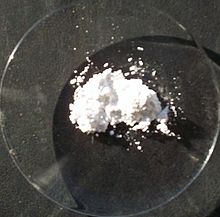
| |
| Names | |
|---|---|
| IUPAC name
Ytterbium(III) oxide.
| |
| Other names
Ytterbia
diytterbium trioxide ytterbium sesquioxide | |
| Identifiers | |
| ChemSpider | |
| ECHA InfoCard | 100.013.850 |
| EC Number |
|
PubChem CID
|
|
| UNII | |
CompTox Dashboard (EPA)
|
|
| Properties | |
| Yb2O3 | |
| Molar mass | 394.08 g/mol |
| Appearance | White solid. |
| Density | 9.17 g/cm3, solid. |
| Melting point | 2,355 °C (4,271 °F; 2,628 K) |
| Boiling point | 4,070 °C (7,360 °F; 4,340 K) |
| Insoluble | |
| Structure | |
| Cubic, cI80 | |
| Ia-3, No. 206 | |
| Octahedral | |
| Thermochemistry | |
Std molar
entropy (S⦵298) |
133.05 J/mol·K [1] |
Std enthalpy of
formation (ΔfH⦵298) |
-1814.600 kJ/mol [1] |
Gibbs free energy (ΔfG⦵)
|
-1726.844 kJ/mol [1] |
| Hazards | |
| GHS labelling: | |

| |
| Warning | |
| H315, H319, H335 | |
| P261, P305+P351+P338[2] | |
| NFPA 704 (fire diamond) | |
| Flash point | Non-flammable. |
| Related compounds | |
Other anions
|
Ytterbium(III) sulfide, Ytterbium(III) chloride |
Other cations
|
Thulium(III) oxide Lutetium(III) oxide |
Except where otherwise noted, data are given for materials in their standard state (at 25 °C [77 °F], 100 kPa).
| |
Ytterbium(III) oxide is the chemical compound with the formula Yb2O3. It is one of the more commonly encountered compounds of ytterbium. It occurs naturally in trace amounts in the mineral gadolinite. It was first isolated from this in 1878 by Jean Charles Galissard de Marignac.[3]
- ^ a b c R. Robie, B. Hemingway, and J. Fisher, “Thermodynamic Properties of Minerals and Related Substances at 298.15K and 1bar Pressure and at Higher Temperatures,” US Geol. Surv., vol. 1452, 1978.[1]
- ^ Sigma Aldrich; rev. 2012-09-19
- ^ Krebs, Robert E.; Déjur, Rae (2006). The history and use of our earth's chemical elements: a reference guide (2nd ed.). Westport, Conn.: Greenwood Press. ISBN 978-0-313-33438-2.
